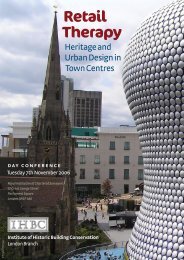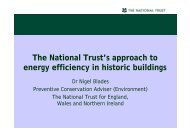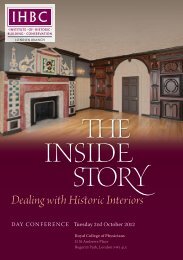CARE Spring/Summer 2012 newsletter - Engineers Ireland
CARE Spring/Summer 2012 newsletter - Engineers Ireland
CARE Spring/Summer 2012 newsletter - Engineers Ireland
Create successful ePaper yourself
Turn your PDF publications into a flip-book with our unique Google optimized e-Paper software.
care<br />
conservation accreditation<br />
register for engineers<br />
<strong>newsletter</strong><br />
NEWS, VIEWS AND INFORMATION<br />
FOR CONSERVATION ENGINEERS<br />
IN THIS ISSUE:<br />
P10 ENGINEERS IRELAND<br />
Supporting <strong>CARE</strong><br />
P11 DEWSBURY MARKET HALL<br />
Conservation repairs<br />
P15 THE HORNIMAN MUSEUM<br />
Recounts of subsidence caused by heat<br />
P16 ST WILFRID’S CHURCH<br />
Repairs to an unusual roof<br />
P18 FORTHCOMING EVENTS<br />
Conservation events and competitions<br />
<strong>Spring</strong>/<strong>Summer</strong> <strong>2012</strong>
There can be no finer tribute<br />
to the energy, passion and community<br />
spirit of the people of Liverpool than the<br />
completed restoration of the Florence<br />
Institute in the Dingle area of the city.<br />
Sited just yards from the River Mersey,<br />
the impressive grade II Listed building<br />
was built in 1889 as a tribute to Florence<br />
Hall, the daughter of former Liverpool<br />
Mayor Bernard Hall who died tragically at<br />
the young age of 22.<br />
For decades the building served the<br />
people of Liverpool and is Britain’s oldest<br />
surviving purpose-built boys’ club. The<br />
Florrie finally closed her doors in 1988<br />
and subsequently fell into disrepair.<br />
York and Manchester based building<br />
restoration contractors William Anelay,<br />
a firm with 265 years experience was<br />
charged with the restoration work under<br />
the auspices of architects Purcell Miller<br />
Tritton LLP and Project Manager Buro<br />
Four on behalf of The Florence Institute<br />
Trust Ltd, set up by local residents in<br />
2005.<br />
The £4.8 million programme of works,<br />
which started in the summer of 2010<br />
and completed in March <strong>2012</strong>, was<br />
funded by the Heritage Lottery Fund in<br />
partnership of european, regional and<br />
local regeneration agencies, including<br />
the Northwest Regional Development<br />
Agency, and ERDF. The project has<br />
converted the former dangerously<br />
derelict and vandalised landmark into<br />
a thriving community resource and<br />
social comprehensive centre, with a well<br />
balanced community and commercial<br />
remit.<br />
William Anelay, has carried the work<br />
out in two distinct phases, to achieve<br />
a ‘very good’ BREEAM rating. The first<br />
four month tranche of activity focused<br />
on initial enabling works to clear the<br />
building and make it safe enough for<br />
the Project Design Team to<br />
safely gain access and assess<br />
for necessary repairs and<br />
alterations with William<br />
Anelay experts on hand to<br />
advise on technical issues.<br />
The second phase of<br />
works began in earnest early<br />
in 2011 and included the<br />
complete repair of external<br />
brickwork and terracotta to all<br />
elevations, the construction<br />
of a new traditional lead and<br />
slate roof and the recreation<br />
and reinstatement of<br />
architectural features such as vents and<br />
the distinctive copper cupola that sits<br />
high above the existing entrance.<br />
Internally the building was restored<br />
and reordered with extensive repairs to<br />
floors and walls and the installation of<br />
new mechanical and electrical services<br />
throughout.<br />
Anelay’s Site Manager Gary Shea<br />
commented: “Arson and vandalism had<br />
taken its toll on the building and left it<br />
disused and structurally compromised<br />
for over two decades. There was a strong<br />
element of risk given the building’s<br />
perilous condition.<br />
“The initial enabling works has paved<br />
the way for transforming the building<br />
back into a valuable community resource.<br />
“The ground floor of the finished<br />
building comprises of a large 220m² gym<br />
facility with library, heritage centre café,<br />
kitchen and toilet facilities as well as a<br />
number of small business units.<br />
“On the first floor there is a large<br />
320m² main hall which will be used for<br />
functions with a stage lift constructed<br />
alongside associated bar facilities.<br />
There’s also a balcony area and steps up<br />
to the observatory upon which a new<br />
copper cupola has been restored.<br />
“Restoring the main hall has been a<br />
complex operation with five huge roof<br />
trusses installed to replace the existing,<br />
heavily damaged beams that had led to<br />
roof collapse and water ingress. Internal<br />
birdcage scaffolding allowed these works<br />
to take place safely with a temporary<br />
external roof covering installed over the<br />
winter months.<br />
Denise Bernard (formerly Devine)<br />
Chair/Trustee of The Florence Institute<br />
Trust Ltd said: “For years, the Florrie<br />
became a blight both visually and<br />
physically on the landscape for local<br />
people and after an arson attack left it<br />
considerably damaged it became clear<br />
that something had to be done. Some<br />
people wanted the Florrie to be razed to<br />
the ground but thankfully the appetite<br />
was there to save her.<br />
“By the <strong>Spring</strong> of <strong>2012</strong> the Florrie will<br />
once again be playing a pivotal role in<br />
this vibrant and diverse community,”<br />
Denise added.<br />
York<br />
Tel: 01904 412 624<br />
Fax: 01904 413 535<br />
Manchester<br />
Tel: 0161 223 7462<br />
Fax: 0161 230 6514<br />
info@williamanelay.co.uk<br />
www.williamanelay.co.uk
<strong>CARE</strong><br />
The Conservation Accreditation Register for <strong>Engineers</strong><br />
The Conservation Accreditation Register<br />
for <strong>Engineers</strong> (<strong>CARE</strong>) identifies civil<br />
and structural engineers skilled in the<br />
conservation of historic structures<br />
and sites. Members have followed a<br />
rigorous approval procedure to confirm<br />
an appreciation of disciplines and<br />
interests extending well beyond their<br />
professional training as engineers. They<br />
have demonstrated that they are fully<br />
conversant with conservation philosophy<br />
and methods applied to heritage<br />
projects.<br />
Additionally, <strong>CARE</strong> has been established to:<br />
▪ Assist clients in selecting an<br />
appropriate engineer with proven<br />
conservation experience<br />
▪ Encourage education and training<br />
in conservation engineering<br />
▪ Promote sympathetic and<br />
‘best practice’ conservation<br />
▪ Raise the awareness of conservation<br />
in the engineering profession<br />
Those who are registered are listed<br />
on the <strong>CARE</strong> website and entitled to<br />
use the descriptor ‘Conservation<br />
Accredited Engineer.’<br />
Further information, application forms<br />
and a list of registered members can be<br />
found at ice.org.uk/care<br />
THE <strong>CARE</strong> PANEL<br />
Chairman<br />
Jon Avent<br />
Technical Secretary<br />
Clive Richardson<br />
IN THIS ISSUE:<br />
P04 WELCOME<br />
Chairs notes<br />
P05 ACCREDITATION UPDATE<br />
News from our partners<br />
P10 ENGINEERS IRELAND<br />
Supporting <strong>CARE</strong><br />
P11 DEWSBURY MARKET HALL<br />
Conservation repairs<br />
P15 THE HORNIMAN MUSEUM<br />
Recounts of subsidence caused by heat<br />
P16 ST WILFRID’S CHURCH<br />
Repairs to an unusual roof<br />
P18 FORTHCOMING EVENTS<br />
Conservation events and competitions<br />
Panel Members<br />
Ian Hume, Terry Girdler,<br />
Lawrance Hurst, John Ruddy,<br />
Charles Blackett-Ord, Sarah Fray<br />
Architect Representatives<br />
Tony Walker, Bob Chittham,<br />
Tim Ratcliffe<br />
RICS Representative<br />
Amanda Watmore<br />
<strong>Engineers</strong> <strong>Ireland</strong> Representative<br />
Roseanna O’Leary<br />
<strong>CARE</strong> Panel<br />
Regional Representatives<br />
Wales, Cadw - Richard Turner<br />
Northern <strong>Ireland</strong>, NIEA - Manus Deery<br />
Scotland, Historic Scotland - David Mitchell<br />
Institution of Civil <strong>Engineers</strong><br />
Tony Blackmore<br />
Awards and Registers Executive<br />
t +44 (0) 20 7665 2102<br />
f +44 (0) 20 7222 7500<br />
e registers@ice.org.uk<br />
ice.org.uk/care<br />
03 <strong>CARE</strong> NEWSLETTER <strong>Spring</strong>/<strong>Summer</strong> <strong>2012</strong> ICE.ORG.UK
Chair Notes<br />
<strong>Spring</strong>/<strong>Summer</strong> <strong>2012</strong><br />
<strong>CARE</strong> Panel Chairman<br />
Jon Avent<br />
NEW MEMBERS<br />
The Panel are pleased to<br />
welcome our newest members of<br />
the <strong>CARE</strong> Register:<br />
▪ Margaret Cooke<br />
▪ Bridget Drake-Wilkes<br />
▪ Jim Kerr<br />
Over the past year the <strong>CARE</strong> Panel has<br />
continued to promote the register with<br />
the on-going support of the Institution<br />
of Civil <strong>Engineers</strong> and the Institution<br />
of Structural <strong>Engineers</strong>. With a stated<br />
objective of promoting accreditation<br />
within the engineering profession<br />
the Panel has sought to widen the<br />
opportunities for engineers working in<br />
the heritage sector. In response to this<br />
objective and also following approaches<br />
from engineers outside of the UK the<br />
first links have been formalised with<br />
<strong>Engineers</strong> <strong>Ireland</strong>, and their chartered<br />
engineers are now able to apply to join<br />
the <strong>CARE</strong> register and achieve the widely<br />
recognised accredited status.<br />
I have been encouraged by the level<br />
of support given by ICE and IStructE<br />
together with <strong>Engineers</strong> <strong>Ireland</strong> in<br />
achieving this agreement and look<br />
forward to welcoming those engineers<br />
who have already expressed interest<br />
in submitting applications. The<br />
significance of this link-up should not<br />
be underestimated, as it recognises that<br />
building conservation needs to embrace<br />
local, national and international<br />
construction skills and techniques,<br />
and that having the ability to share<br />
knowledge and experience across a<br />
wider spectrum is to everyone’s benefit.<br />
We only have to look at the on-going<br />
heritage loss in New Zealand and<br />
the recent proposals to demolish<br />
Christchurch Cathedral to recognise the<br />
specific need for engineers across the<br />
world with highest possible standards of<br />
in-depth and wide ranging experience of<br />
traditional buildings and structures.<br />
The New Zealand Historic Places Trust<br />
believes retaining both the cathedral and<br />
other heritage central city landmarks<br />
would help Christchurch’s recovery by<br />
reinstating cultural tourism. Having<br />
professionals with universally recognised<br />
experience of heritage structures can<br />
only assist with ensuring that all options<br />
are fully explored. With ICE and IStructE<br />
members practicing across the world<br />
these would be areas where we can, and<br />
should, encourage those working in the<br />
heritage and traditional buildings sectors<br />
to consider applying to join <strong>CARE</strong>.<br />
Options to forge links in a similar manner<br />
to that formed with Engineer <strong>Ireland</strong><br />
should also be explored and encouraged;<br />
particularly now the first steps on this<br />
path have been successfully negotiated.<br />
Jon Avent<br />
BSc(Hons) CEng MIStructE IHBC<br />
Accredited Conservation Engineer<br />
Chair <strong>CARE</strong> Panel<br />
ICE.ORG.UK<br />
04 <strong>CARE</strong> NEWSLETTER <strong>Spring</strong>/<strong>Summer</strong> <strong>2012</strong>
Accreditation Update<br />
Our partners<br />
The principal construction professions<br />
of Architecture, Building Surveying and<br />
Engineering all have strong accreditation<br />
schemes that formally assess and<br />
approve an individual’s experience<br />
and competency working within the<br />
field of building conservation. The<br />
recent issue of the Home Countries<br />
Protocol on Accreditation is a formal<br />
acknowledgement of the need and<br />
benefits offered by recognised schemes<br />
and a welcome recent progression.<br />
These accreditation schemes recognised<br />
by the UK’s principal conservation<br />
Home Countries Accreditation Prorocol<br />
Criteria against which<br />
Accreditation Schemes would be<br />
considered by the Home Countries:<br />
Accreditation of individuals rather<br />
than companies or practices.<br />
The skills of a practice are only the<br />
combined skills of its individual members,<br />
and as individuals move, the skills of the<br />
practice will vary.<br />
Eligibility of all suitably qualified and<br />
experienced professionals to gain<br />
accreditation.<br />
Schemes should be open to all members<br />
of the relevant professional discipline<br />
Assessment of a verifiable record of<br />
work carried out.<br />
Accreditation needs to be a measure<br />
of experience and competence, so<br />
assessment cannot be based simply on<br />
a statement of philosophy or principles.<br />
organisations and in many instances<br />
have become a specific requirement for<br />
working on heritage projects.<br />
The following pages provide an overview<br />
of the principal accreditation schemes<br />
operated for professionally qualified<br />
individuals working in the heritage sector.<br />
Whilst the IHBC scheme is different to<br />
the accreditation schemes operated by<br />
the principal professions of Architecture,<br />
Engineering and Surveying, it does provide<br />
a significant membership and skills base<br />
which is recognised across a wide range<br />
of built heritage professionals.<br />
Assessment by suitably experienced,<br />
impartial assessors against agreed criteria.<br />
Peer assessment, together with<br />
reassessment on a regular basis<br />
(say every 5 years) to ensure that<br />
accreditation indicates current<br />
competence.<br />
The use of the ICOMOS Guidelines for<br />
Education and Training in the Conservation<br />
of Monuments, Ensembles and Sites.<br />
These are agreed as the basis of<br />
assessment of candidates’ experience.<br />
A credible ethical and linked disciplinary<br />
framework to ensure that standards are<br />
observed and maintained.<br />
There needs to be a way in which<br />
proper account is taken of examples of<br />
competence falling below the standards<br />
required by accreditation<br />
THE <strong>CARE</strong> REGISTER<br />
<strong>CARE</strong> is administered by the<br />
Institution of Civil <strong>Engineers</strong> (ICE)<br />
and the Institution of Structural<br />
<strong>Engineers</strong> (IStructE) and has been<br />
established to identify engineers<br />
skilled in the conservation of<br />
historical structures and sites, be<br />
they buildings, bridges, harbours,<br />
riverbanks, canals, industrial sites<br />
or natural landscapes. These<br />
engineers may either be working<br />
as lead consultants on projects<br />
where engineering is dominant or<br />
as sub-consultants where there<br />
is structural engineering content.<br />
They must have an appreciation of<br />
disciplines and interests extending<br />
well beyond their professional<br />
training as engineers and show that<br />
they understand the philosophy<br />
and methods applicable to the<br />
conservation of historic work.<br />
The Register is intended as a means<br />
of encouraging engineers to raise<br />
their awareness and standards<br />
by pursuing their continuing<br />
professional development in this<br />
specialist field.<br />
05 <strong>CARE</strong> NEWSLETTER <strong>Spring</strong>/<strong>Summer</strong> <strong>2012</strong> ICE.ORG.UK
RIBA<br />
The RIBA’s Register of accredited<br />
conservation architects was launched<br />
in 2010. It enables those looking to<br />
commission work on heritage buildings<br />
to find architects with the specific<br />
skills and experience they require,<br />
encompassing all aspects of historic<br />
building conservation, repair and<br />
maintenance.<br />
Recognising the distinctive nature of<br />
conservation work, and moving away<br />
from a ‘one size fits all’ approach, the<br />
Register operates upon three levels of<br />
membership, which also provide an<br />
incremental process of accreditation<br />
for those who are in the early phases<br />
of establishing their careers in building<br />
conservation:<br />
▪ Specialist Conservation Architect<br />
(SCA): For those working on historic<br />
buildings of out-standing national<br />
importance, such as Grade I and II*<br />
listed buildings or scheduled<br />
monuments, and with highly<br />
specialist skills in one or more<br />
aspects of conservation.<br />
▪ Conservation Architect (CA): Suitable<br />
for those working on Grade II listed<br />
buildings, regionally important<br />
historic buildings and in sensitive<br />
historic environments.<br />
▪ Conservation Registrant (CR):<br />
For those working on the repair,<br />
maintenance, alteration and<br />
refurbishment of heritage buildings,<br />
e.g. unlisted buildings in Conservation<br />
Areas, locally important historic<br />
buildings and the general pre 1919<br />
building stock.<br />
The RIBA Conservation Register is<br />
endorsed by English Heritage and<br />
Historic Scotland, who recognise the SCA<br />
level only for grant purposes.<br />
More information can be found on<br />
www.architecture.com<br />
ICE.ORG.UK<br />
06 <strong>CARE</strong> NEWSLETTER <strong>Spring</strong>/<strong>Summer</strong> <strong>2012</strong>
AABC<br />
The Register of Architects Accredited in<br />
Building Conservation is an independent<br />
accreditation body established in 1999<br />
with the active support of English<br />
Heritage. The purpose of the Register is<br />
to protect the historic built environment<br />
from damaging interventions devised<br />
by people not skilled in historic building<br />
conservation and adaptation. It does so<br />
by publishing, for the benefit of clients,<br />
a register of architects whose work and<br />
skills in building conservation have been<br />
established by careful assessment.<br />
AABC’s twenty assessment teams<br />
each comprise two accredited<br />
conservation architects and one lay<br />
person knowledgeable in the field and<br />
usually from a client background. Lay<br />
involvement in the accreditation process<br />
ensures the Register’s objectivity and<br />
client emphasis. Executive architects who<br />
personally devise and produce contract<br />
documentation and administer contracts<br />
make up the majority of the register<br />
and may use the suffix AABC (Architect<br />
Accredited in Building Conservation).<br />
Architects acting in more of an advisory<br />
or managerial capacity, perhaps leading<br />
several projects or acting as conservation<br />
officers but not personally producing<br />
detailed documentation or carrying out<br />
contract supervision,<br />
may apply for accreditation as a<br />
consultant architect.<br />
Similarly, specialist architects practising<br />
as conservators or researchers and<br />
having only a limited involvement in<br />
projects may also be accredited as<br />
a consultant architect. In this case<br />
registrants may use the suffix CAABC<br />
(Consultant Architect Accredited in<br />
Building Conservation).<br />
There are over 400 architects listed<br />
on the Register. AABC’s website offers<br />
detailed guidance on core conservation<br />
principles, key competences and<br />
the preparation of applications for<br />
accreditation. AABC also operates an<br />
Apprentice scheme which offers a<br />
structured pro-gramme of mentoring<br />
and guidance to younger architects<br />
who wish to become accredited. Since<br />
the Register was established AABC has<br />
become a benchmark in historic building<br />
conservation. Membership has increased<br />
regularly over the last twelve years and<br />
continues to grow.<br />
More information can be found on<br />
www.aabc-register.co.uk<br />
07 <strong>CARE</strong> NEWSLETTER <strong>Spring</strong>/<strong>Summer</strong> <strong>2012</strong><br />
ICE.ORG.UK
RICS<br />
The RICS Building Conservation<br />
Accreditation Scheme (BACS) was<br />
established in 1992 to provide a register<br />
of individuals knowledgeable in the field<br />
of conservation of historic buildings<br />
or sites. Since its introduction the<br />
scheme has promoted good practice and<br />
standards and has gone on to become<br />
recognised and respected throughout<br />
the industry.<br />
The aim of the scheme is to provide a<br />
register of individuals with experience<br />
and knowledge in the field of<br />
conservation of historic buildings or sites.<br />
The scheme has the backing of<br />
English Heritage who will only select<br />
professionals form a number of approved<br />
bodies, RICS being one of these.<br />
There are currently two routes into<br />
accreditation depending on educational<br />
attainment and experience.<br />
▪ Experienced – Only route for<br />
applicants with no posts graduate<br />
academic qualification in Building<br />
Conservation; or<br />
▪<br />
Academic – For applicants with<br />
experience and a recognised post<br />
graduate academic qualification in<br />
Building Conservation.<br />
Members of the Building Conservation<br />
Accreditation Scheme are subject to<br />
ongoing monitoring by RICS Regulation.<br />
Accredited members of the Building<br />
Conservation Accreditation Scheme are<br />
required to provide details of continued<br />
involvement in building conservation on<br />
an annual basis by submitting details of<br />
their CPD records, and any additional<br />
documentation that may be required.<br />
The register of fully accredited members<br />
is updated regularly and is available<br />
to the public and other client groups<br />
through RICS information services and<br />
the RICS Website.<br />
More information of the scheme can be<br />
found on www.rics.org<br />
ICE.ORG.UK<br />
08 <strong>CARE</strong> NEWSLETTER <strong>Spring</strong>/<strong>Summer</strong> <strong>2012</strong>
IHBC<br />
Membership of the IHBC differs<br />
from other accreditation schemes<br />
as assessment concentrates on<br />
competence across conservation advice<br />
and processes. IHBC accreditation<br />
demands com-petent standards across<br />
the key stages of conservation: valuing<br />
and managing heritage, and where<br />
appropriate changing it for the better<br />
through intervention (illus). If applicants<br />
do not demonstrate competence in their<br />
primary discipline, they cannot satisfy the<br />
demands of IHBC accreditation.<br />
Applicants are not expected to be experts<br />
across each stage of conservation,<br />
but must demonstrate competence<br />
outside their specialist area. The<br />
application process ensures applicants<br />
consider conservation skills holistically,<br />
acknowledging what they do not know<br />
as well as what they do. This satisfies<br />
the spirit of the 1993 ICOMOS guidelines<br />
as well as the letter. Also, applicants<br />
might come from any discipline, but must<br />
also articulate and verify a high-level<br />
balance of skills, knowledge and<br />
experience across conservation, all to<br />
the satisfaction of an inter-disciplinary<br />
panel of assessors.<br />
Unlike other professional bodies, the<br />
IHBC do not re-accredit members, but<br />
operate a disciplinary process tied to<br />
a Code of Conduct, that provides a<br />
continual monitoring of conservation<br />
standards in accredited members.<br />
Like others systems, the IHBC does not<br />
accredit businesses, but does ‘recognise’<br />
them through a quality-assurance<br />
listing called HESPR. The services these<br />
businesses provide are tied to the IHBC<br />
standards through employees who are<br />
also IHBC accredited members.<br />
IHBC: www.ohbc.org.uk<br />
HESPR: www.ihbc.org.uk/hespr/<br />
Contact: Sean O’Reilly,<br />
director@ihbc.org.uk<br />
The IHBC’s Conservation Cycle<br />
informs our accreditation as<br />
applicants must demonstrate<br />
skills across the cycle from<br />
valuing and management to,<br />
where appropriate, intervention.<br />
09 <strong>CARE</strong> NEWSLETTER <strong>Spring</strong>/<strong>Summer</strong> <strong>2012</strong> ICE.ORG.UK
<strong>Engineers</strong> <strong>Ireland</strong><br />
Supporting <strong>CARE</strong><br />
Restoration of Dunboy Castle<br />
by Cork based conversation<br />
engineers, Southgate<br />
Associates<br />
John Power, Director General<br />
of <strong>Engineers</strong> <strong>Ireland</strong> and<br />
Sarah Fray, Technical<br />
Director of Institution of<br />
Structural <strong>Engineers</strong> signing<br />
formal agreement.<br />
With <strong>CARE</strong> providing the framework to<br />
promote engineering standards within<br />
the heritage sector and with growing<br />
recognition of the benefits of achieving<br />
formal accreditation it is a welcome<br />
and logical step for <strong>Engineers</strong> <strong>Ireland</strong><br />
to provide its support to the register.<br />
Following the recent formalising of links<br />
with the register, Chartered members of<br />
<strong>Engineers</strong> <strong>Ireland</strong> are now eligible to apply<br />
to join the register by following the same<br />
application process open to chartered<br />
members of ICE and IStructE.<br />
For those unfamiliar with <strong>Engineers</strong><br />
<strong>Ireland</strong>, the working title for “The<br />
Institution of <strong>Engineers</strong> of <strong>Ireland</strong>” it<br />
traces its origins back to 1835 when a<br />
group of leading Irish engineers formed<br />
a society to promote the civil engineering<br />
profession and share their experiences.<br />
In 1844 the organisation became the<br />
Institution of Civil <strong>Engineers</strong> of <strong>Ireland</strong><br />
and 33 years later in 1877 became one<br />
of the first chartered institutions in the<br />
British Isles. Cumann na nInnealtoiri (The<br />
<strong>Engineers</strong> Society) was founded in 1928<br />
to advance the prospects and status of its<br />
members.<br />
In 1969 the Oireachtas (national<br />
parliament ) passed the Institution<br />
of Civil <strong>Engineers</strong> of <strong>Ireland</strong> (Charter<br />
Amendment) Act, 1969 and following<br />
this the Institution of Civil <strong>Engineers</strong> and<br />
Cumann na nInnealtóirí merged to form<br />
the Institution of <strong>Engineers</strong> of <strong>Ireland</strong>,<br />
later rebranded as <strong>Engineers</strong> <strong>Ireland</strong>.<br />
The new institution widened its scope to:<br />
Cater for all engineering disciplines<br />
Ensure standards in the profession<br />
▪ Promote engineering as a career<br />
▪ Encourage Continuing Professional<br />
Development for engineers<br />
▪ Represent the interests of the<br />
engineering profession in <strong>Ireland</strong> and<br />
internationally<br />
<strong>Ireland</strong> has a rich and varied built heritage<br />
spanning many centuries. Throughout the<br />
country there are many building types and<br />
structures represented, some of which are<br />
unique to the country. This built heritage<br />
takes the form of large estate houses,<br />
vernacular heritage such as thatched<br />
cottages, industrial related structures<br />
such as canals, bridges, mill buildings and<br />
warehouses with planning authorities<br />
obliged to have a Record of Protected<br />
Structures (RPS). Owners and occupiers of<br />
protected buildings are required to ensure<br />
that buildings do not become endangered<br />
through harm, decay or damage.<br />
Having widely recognised professional<br />
conservation accreditation standards<br />
to support this process and provide the<br />
highest standard of advice is undoubtedly<br />
a benefit to all concerned. <strong>Engineers</strong><br />
<strong>Ireland</strong> look forward to developing and<br />
growing strong links across the heritage<br />
sector through their support of <strong>CARE</strong>.<br />
Further details can be found on <strong>Engineers</strong><br />
<strong>Ireland</strong> website at<br />
http://www.engineersireland.ie/care/<br />
ICE.ORG.UK<br />
10 <strong>CARE</strong> NEWSLETTER <strong>Spring</strong>/<strong>Summer</strong> <strong>2012</strong>
Dewsbury Market Hall<br />
Conservation repairs<br />
Ian Andrew CEng MICE MIStructE, WYG Engineering Limited, August 2011<br />
The cast-iron and steel framed Dewsbury<br />
Market Hall, which is owned by Kirklees<br />
Metropolitan Council and stands in<br />
Dewsbury Conservation Area, was erected<br />
in 1903 and 1904 to the design of local<br />
architect and borough engineer Henry<br />
Dearden (Associate Member of the ICE),<br />
by H E Hodgson & Co, Contractors.<br />
The hall is a single-storey four-bay framed<br />
building comprising an array of cast-iron<br />
columns supporting a series of riveted<br />
steel plate-and-angle perimeter beams,<br />
and three intermediate lattice girders<br />
made from steel plates and angles<br />
spanning east-west at valley positions.<br />
The roof structure comprises a series of<br />
45-degree duo-pitched tied-arch trusses<br />
made from steel plates, rods and angles<br />
such that they span north-south from the<br />
perimeter girders on the south and north<br />
sides and the intermediate lattice girders.<br />
The four roof bays are hip-ended, and the<br />
half-trusses for these are supported by the<br />
east and west perimeter girders. The plan<br />
shape of the building is approximately an<br />
equilateral rhombus, the overall lengths<br />
of each side being just over thirty metres.<br />
The height to the eaves is approximately<br />
8.5 metres.<br />
Lateral stability in the structure is obtained<br />
through gravity and nominal connections<br />
via the tapped location bolts between<br />
the roof structure and the column tops,<br />
assisted by cantilever action assumed to<br />
be available from the foundations.<br />
In practice, this is probably also assisted<br />
by the timber-framed glazing that exists<br />
between the undersides of the perimeter<br />
girders and RSJs above shop-front level.<br />
During routine re-painting in 2006,<br />
severe local corrosion was discovered in<br />
concealed steelwork above a cast-iron<br />
stanchion in the north-east corner of the<br />
market hall. Intrusive inspection behind<br />
the decorative cast-iron box-castings<br />
above remaining perimeter column<br />
tops revealed that severe corrosion was<br />
present at all these locations. The interior<br />
column tops, which are not concealed by<br />
decorative castings, were found to be free<br />
of damaging corrosion. The expansive<br />
action due to this highly-localised<br />
corrosion had lifted the perimeter beams<br />
by up to 25mm, such that many of the<br />
tapped location bolts fitted through the<br />
bearing areas had failed in tension.<br />
At several column tops, the perimeter<br />
beam webs had failed causing beam<br />
sections to settle onto the glazed screens<br />
below. In addition, the bolts that secured<br />
the ends of the intermediate lattice girders<br />
to the east- and west perimeter beams<br />
had failed due to corrosion of the beam<br />
webs.<br />
The cause of the corrosion was electrolytic<br />
action between the dissimilar metals.<br />
This was promoted by the damp and<br />
dirty conditions that prevailed behind the<br />
castings, aggravated because the column<br />
shafts had also been used to convey<br />
rainwater to the public drainage system.<br />
It is thought that the damage had been<br />
present for a long time.<br />
PROJECT INFORMATION<br />
Existing part-section through roof<br />
Cleaned-up column top revealing<br />
necked location bolts<br />
Decorative box-casting removed reveals lattice<br />
girder end bolts have failed<br />
11 <strong>CARE</strong> NEWSLETTER <strong>Spring</strong>/<strong>Summer</strong> <strong>2012</strong> ICE.ORG.UK
PROJECT INFORMATION<br />
Detail of existing part-elevation of column<br />
top and perimeter beams<br />
Cutting out corroded steel in<br />
perimeter beams<br />
Detail of proposed repair to<br />
column top using UB<br />
The design principle for permanent<br />
repair was to reinstate the function<br />
of the perimeter beams and to ensure<br />
their bearings on the tops of the<br />
columns would be even (by removal of<br />
eccentricity induced by corrosion). Various<br />
improvements to prevent further corrosion<br />
were specified, including application<br />
of a two-pack epoxy protective paint<br />
system and introduction of a contactbreaker<br />
barrier between the new UB<br />
bearing flanges and the existing column<br />
tops. This principle allowed a minimal<br />
intervention route to be followed so that<br />
as much of the original fabric could be<br />
retained as possible.<br />
The worst-affected areas were shored<br />
immediately to prevent further<br />
settlement. The presence of Batley<br />
Beck culvert very close to the east side<br />
was taken into account in the shoring<br />
scheme. The shoring, which was<br />
extended to provide temporary support<br />
for all perimeter beams, included a<br />
device to allow the perimeter beam<br />
ends to be jacked up slightly if desired<br />
to permit accurate realigning and relevelling<br />
following implementation<br />
of permanent repairs. The method of<br />
implementing these repairs as originally<br />
designed was to cut out the corroded<br />
parts of the perimeter beams where<br />
they pass over each column and replace<br />
them with short UB sections spliced<br />
to the remaining beam sections, thus<br />
reinstating the bearings. This work also<br />
reinstated horizontal continuity in the<br />
perimeter beams across the column tops.<br />
However, at the start of the work on site<br />
it was decided that the new UB sections<br />
would be too heavy to install easily.<br />
Whilst maintaining the design principle,<br />
the detail was therefore amended using<br />
folded steel plate and angle sections<br />
assembled on site. This had a further<br />
advantage that jacking was not required<br />
as the components were able to be<br />
fabricated on site to suit the distorted<br />
shape of the perimeter beam. The<br />
disadvantage is that the perimeter beams<br />
have been left in their distorted positions,<br />
although this has minimal visual effect.<br />
The tolerance gaps under the new<br />
bearings were grouted using a specialist<br />
cementitious mortar. The grout also<br />
ensured there will be no direct contact<br />
between differing metals (mortar is a<br />
non-conductor and is alkaline), thus<br />
providing passive protection against<br />
future electrolytic action. The boxcasting<br />
pieces, which had been cut up<br />
to allow them to be removed for access,<br />
were bolted to the structure and the cut<br />
edges cold-stitched back together, thus<br />
completing the repair work.<br />
Certain other minimally-intrusive repairs<br />
and alterations were also incorporated<br />
to improve the structural performance<br />
of the building. The scaffolded work<br />
area at roof level provided for general<br />
refurbishment work presented an<br />
opportunity to improve this public<br />
building’s resistance to accidental<br />
horizontal loading (noting the existence<br />
of cast-iron in the primary load path).<br />
ICE.ORG.UK<br />
12 <strong>CARE</strong> NEWSLETTER <strong>Spring</strong>/<strong>Summer</strong> <strong>2012</strong>
This was done by removing the<br />
considerable “slack” in the existing<br />
tie-chords between the feet of the roof<br />
arches (there had been insufficient<br />
provision for tightening the tie-chords<br />
originally), so making the connection<br />
between the roof structure and the<br />
column tops more positive. This was<br />
done by inserting a new longitudinal<br />
carbon-steel tie-rod at tie-chord level in<br />
each of the four bays of the roof so that<br />
the existing tie-chords could be alternately<br />
displaced sideways and locked off against<br />
the new tie-rods. The number of bolts<br />
tapped into the cast-iron of the column<br />
tops was also increased where space<br />
permitted, to improve general robustness<br />
at column-top level.<br />
Kirklees Metropolitan Council recognised<br />
that the building, whilst not listed, is in a<br />
conservation area, and that it was unlikely<br />
that the local community would have<br />
accepted replacement of their market hall<br />
without such repairs. In addition to<br />
following the chief principle of working<br />
with historic buildings, viz. minimal<br />
intervention to the fabric of the building, a<br />
high degree of sustainability was therefore<br />
achieved during repair of the market hall.<br />
PROJECT INFORMATION<br />
New folded-plate splice delivered to site<br />
New steel splice fitted up on<br />
existing column top<br />
Project Statistics:<br />
Client:<br />
Kirklees Metropolitan Council<br />
Architect:<br />
Aedas Building Surveying Limited<br />
Structural Engineer:<br />
WYG Engineering Limited<br />
Main Contractor:<br />
Richardson Projects Limited<br />
Cast-Iron Sub-Contractor:<br />
Casting Repairs Limited<br />
Project Cost:<br />
£1.2 million<br />
Completed repair awaiting<br />
grouting and painting<br />
Exterior view after completion<br />
13 <strong>CARE</strong> NEWSLETTER <strong>Spring</strong>/<strong>Summer</strong> <strong>2012</strong> ICE.ORG.UK
The Horniman Museum<br />
Recounts of subsidence caused by heat<br />
Clive Richardson, a Technical Director<br />
of URS, and their Conservation Team<br />
Leader, recounts the surprising case<br />
of subsidence caused by heat from a<br />
basement boiler room.<br />
After 90 years of stability, part of the<br />
Horniman Museum in South London<br />
suddenly started to subside. Its heating<br />
system had baked the clay ground<br />
beneath it. This adversity was turned<br />
to advantage with underpinning to<br />
make new basement space. Top-down<br />
construction was used for temporary<br />
stability and to conserve the unique tiled<br />
ground floor.<br />
The Horniman Museum was built in 1901<br />
at Forest Hill in South London. Designed<br />
by Charles Harrison Townsend in the<br />
Art Nouveau style for the tea merchant,<br />
Frederick Horniman, it is now listed<br />
Grade II star. Behind its stone façade<br />
are two original exhibition halls with<br />
brick cladding, founded on concrete strip<br />
foundations, stepping up the shrinkable<br />
London Clay hillside.<br />
The superstructure is distinctive for its use<br />
of all three metals: riveted wrought iron<br />
barrel-vaults, cast-iron balcony columns,<br />
and mild steel filler-joist gallery floors.<br />
The floors have mass concrete groundbearing<br />
slabs with perimeter ducts which<br />
deliver heat through their floor gratings<br />
by convection from water pipes heated by<br />
basement boilers.<br />
One day it was noticed that some of the<br />
tall glass exhibition cabinets in the south<br />
hall were tilting. Part of the floor and the<br />
column supporting the end balcony over it<br />
had sunk 100mm.<br />
A trial-pit was dug through the floor, and<br />
we were greeted by a blast of hot air! The<br />
clay had shrunk away from the floor leaving<br />
a gap under the floor slab through which<br />
hot air was escaping from the heating<br />
ducts. Fortunately the basement heating of<br />
the north hall had been de-commissioned<br />
many years ago, so the problem only<br />
affected the south hall.<br />
The clay had been baked as hard as brick<br />
to a depth of four metres. It had lost its<br />
clay-like properties. When a lump was<br />
placed in water, instead of re-hydrating<br />
and swelling, the clay disintegrated and<br />
collapsed to a powder. Indeed, the case<br />
was so singular that the Building Research<br />
Establishment offered their services free of<br />
charge.<br />
There was concern that if the water table<br />
rose, wholesale collapse of the baked clay<br />
could occur, which would not just affect the<br />
floor slab, but also the foundations of the<br />
hall. It was decided to remove the baked<br />
clay, and rather than backfill the 4m deep<br />
excavation, the museum’s Trustees asked<br />
for a new basement to be created instead,<br />
as they were short of space.<br />
Top-down construction was chosen, to<br />
maintain lateral stability of the existing<br />
shallow foundations. Mining techniques<br />
were used to burrow under the tiled ground<br />
floor between the south and north halls,<br />
and not a single tile was lost in the process.<br />
As the museum had always been free and<br />
the Trustees had never sought funding,<br />
English Heritage gave them a 100% grant<br />
of £1.1m to do the work. “Free Museum”<br />
is still emblazoned in stone over its<br />
entrance to this day, and it is now free from<br />
subsidence too!<br />
PROJECT INFORMATION<br />
Trial pit through ground floor slab,<br />
revealing clay beneath baked like brick.<br />
Heating ducts beneath the floor, dropped<br />
away from floor slab.<br />
Cracked column casing, hanging from<br />
balcony above.<br />
15 <strong>CARE</strong> NEWSLETTER <strong>Spring</strong>/<strong>Summer</strong> <strong>2012</strong> ICE.ORG.UK
PROJECT INFORMATION<br />
Truss and Soffit of Deck in Roof Void<br />
Ceiling Support System in Roof Void<br />
Cherry Picker for Opening Up Work<br />
St Wilfrid’s Church<br />
Repairs to an unusual roof<br />
Michael Taylor BSc CEng MICE Conservation Accredited Engineer February <strong>2012</strong><br />
The church<br />
St Wilfrid’s is a Grade II* listed Anglican<br />
Church situated off Selby Road, Halton,<br />
Leeds, built in 1938 and designed by the arts<br />
and crafts architect A. Randall Wells.<br />
The building is steel framed, with stanchions<br />
and concrete cased beams. The shallow<br />
pitched roof consists of steel trusses at<br />
3m centres, spanning 9m across the Nave,<br />
Transept or Chancel. Between the trusses<br />
are corrugated asbestos sheets with infill<br />
reinforced concrete. The deck is then<br />
waterproofed with mastic asphalt.<br />
Suspended from the trusses is a vaulted<br />
ceiling consisting of strawboard and plaster<br />
skim on a light steel frame.<br />
The problem<br />
The asphalt is reaching the end of its life<br />
and the roof has been leaking for some time.<br />
With asbestos present, it was undesirable<br />
to disturb, so over-roofing was proposed,<br />
using zed purlins, ply decking and either<br />
asphalt or a single ply membrane. Blackett-<br />
Od Conservation were engaged to advise on<br />
structural implications.<br />
On-Site investigations<br />
Since the over-roofing scheme represented<br />
an increase in load, it was necessary to check<br />
the existing roof structure for this addition.<br />
No drawings of the existing structure were<br />
available, so compact mobile elevated<br />
working platforms were used to inspect<br />
concealed structure through holes cut in the<br />
vaulted false ceiling. Some opening up was<br />
also carried out on the roof to check the<br />
asphalt thickness and deck construction.<br />
Asbestos and concrete<br />
decking system<br />
The decking system was unusual, so it was<br />
important to learn more.<br />
Investigations revealed:<br />
▪ The decking is a 3” deep corrugated<br />
asbestos system with concrete filled<br />
corrugations<br />
▪ Each corrugation has two steel reinforcing<br />
bars, each of which consists of two 6mm<br />
diameter strands twisted together<br />
▪ Below the corrugated asbestos is a flat<br />
asbestos soffit board, somehow bonded<br />
or fixed to the corrugated sheet above.<br />
We could see no physical fixings<br />
▪ There were occasional transverse 0.5mm<br />
cracks in the flat soffit asbestos sheets<br />
which sounded hollow when tapped,<br />
calling into question the bond between<br />
corrugated and flat sheets<br />
A desk study included contacting the ICE and<br />
IStructE libraries and the Civil Engineering<br />
Heritage Exchange (CEHX). The Civils library<br />
came up with a technical article from the<br />
Indian Concrete Journal of November 1943<br />
and an advertisement from a publication<br />
called “Specification 1937”. It concluded the<br />
product was “Handcraft Reinforced Decking”<br />
manufactured by Universal Asbestos, Watford.<br />
The Indian paper gave load tables suggesting<br />
that the maximum span for the 3” deep<br />
section was 6 feet. Since we had 3” sections<br />
spanning 10 feet, this was of concern.<br />
Checking by calculation the 3” deep<br />
reinforced section, we found that strength<br />
was adequate, but deflection exceeded<br />
acceptable limits.<br />
Roof truss analysis<br />
In parallel to the investigations into the<br />
decking system, we needed to check the<br />
roof trusses for increased loads. The trusses<br />
were made with steel angles, bolted to steel<br />
gussets. There was some slight surface<br />
corrosion generally, although more serious<br />
ICE.ORG.UK<br />
16 <strong>CARE</strong> NEWSLETTER <strong>Spring</strong>/<strong>Summer</strong> <strong>2012</strong>
where the roof had leaked.<br />
With the trusses made around 1938 we<br />
used figures from the Historical Structural<br />
Steelwork Handbook, taking a permissible<br />
bending stress of 8.0 tons/in2 (123.6 N/<br />
mm2) and compressive stress of 7.2 tons/<br />
in2 (110.7 N/mm2). Checks were done to BS<br />
449 with a 5% section loss due to corrosion<br />
assumed. Calculations suggested 20%<br />
overstress in the bottom chord which could<br />
be eliminated by two simple additional ties<br />
per truss. Unfortunately access to the trusses<br />
would be difficult.<br />
Conclusions<br />
A dilemma existed. The over-roofing was<br />
possible and relieved the present decking<br />
system of superimposed load, thus<br />
minimising the deflection problem. Although<br />
the bond between sheets was questionable,<br />
there had been no historic failures and<br />
should such a failure occur, the vaulted<br />
ceiling below appeared robust enough to<br />
prevent any flat sheet falling. However, there<br />
were disadvantages:<br />
▪ Possible future failure of the bond<br />
between asbestos sheets was undesirable<br />
▪ It would be difficult to inspect and<br />
maintain the decking system and<br />
structure, which would be concealed from<br />
below and above<br />
▪ Health issues with asbestos<br />
▪ It would be difficult to properly inspect,<br />
repair, strengthen and paint the steelwork,<br />
which all were considered important<br />
requirements of the present scheme<br />
The alternative was to remove the concrete<br />
and asbestos deck entirely replacing it with<br />
a simple timber joisted roof, thus eliminating<br />
the above problems and giving good<br />
temporary access for painting and repairing<br />
steel. However it would be expensive,<br />
particularly with the need to erect temporary<br />
scaffolding roof and devise a means of<br />
manhandling heavy deck units.<br />
After much deliberation and discussion<br />
amongst the design team, the Church and<br />
English Heritage, it was decided to proceed<br />
with the decking removal.<br />
Situation now<br />
The budget for Phase 1 of the work, which<br />
includes the Chancel roof, Aisles roof, repairs<br />
to Chancel windows, concrete repairs and<br />
other maintenance items is £650,000,<br />
excluding fees and VAT. Tenders have been<br />
received but as yet no contractor has been<br />
appointed. It is anticipated that the work<br />
will go ahead later this year, when we will<br />
endeavour to report further.<br />
PROJECT INFORMATION<br />
External View from South East<br />
Exterior View from South West<br />
Acknowledgements:<br />
Client:<br />
Design Team:<br />
Advice and<br />
Principal Grant:<br />
The PCC, St Wilfrid’s Church, Halton<br />
Andrew Boyce (Architect) of Ferry and Mennim, York Blackett-Ord<br />
Conservation <strong>Engineers</strong> (Structural <strong>Engineers</strong>)<br />
ohn Broomfield (Corrosion and Concrete Repair Specialist)<br />
Turner and Holman, York, (Quantity Surveyors) Mason Clark Associates<br />
(CDM Co-ordinator)<br />
English Heritage<br />
Truss corrosion at roof leak<br />
17 <strong>CARE</strong> NEWSLETTER <strong>Spring</strong>/<strong>Summer</strong> <strong>2012</strong> ICE.ORG.UK
FURTHER INFORMATION<br />
Competition<br />
Terms and Conditions<br />
There is no specific guidance on the<br />
theme of photograph so we hope<br />
to receive entries showing the full<br />
spectrum of conservation, including<br />
the good and even ‘the bad’<br />
Maximum of three entries permitted<br />
per person.Photographs to be A4<br />
size at 300 dpi resolution and in<br />
jpg format.Include a brief title and<br />
summary of the picture(s).<br />
By entering you are confirming<br />
that you hold the copyright of the<br />
photograph(s) and grant <strong>CARE</strong>, ICE,<br />
IStructE and Donhead Publishing<br />
Ltd the right to use photographs in<br />
subsequent publicity.<br />
Closing date for submissions is<br />
31 August <strong>2012</strong>.<br />
The competition is open to all, with<br />
the exception of the <strong>CARE</strong> Panel.<br />
Winning submissions will be<br />
notified by 30 September <strong>2012</strong>, and<br />
will be published in the next edition<br />
of the <strong>CARE</strong> <strong>newsletter</strong>.<br />
Forthcoming Events<br />
Conservation events and competitions<br />
Photographic Competition<br />
The photographic competition which<br />
ran in the previous <strong>newsletter</strong> generated<br />
some confusion on eligibility for<br />
submitting entries. The only persons<br />
excluded from entering were members<br />
of the <strong>CARE</strong> Panel, effectively opening<br />
the competition to all others. To redress<br />
this, and to ensure those wishing to<br />
enter are given reasonable opportunity,<br />
it has been decided to award one book<br />
in this edition of the <strong>newsletter</strong>, and to<br />
extend the completion deadline to the<br />
31st August <strong>2012</strong> for the remaining two<br />
publications on offer. All photographs<br />
currently submitted will remain open<br />
for consideration.<br />
Forthcoming events<br />
The Panel are pleased to confirm that<br />
the photograph selected from existing<br />
entries is The Mesquita, Cordoba, Spain<br />
submitted by John Watt.<br />
This profoundly peaceful building is an<br />
11th-Century Moorish mosque with<br />
a Baroque cathedral built through its<br />
centre after the retaking of Cordoba by<br />
the Christian Spanish monarchy. The<br />
building is a unique and enchanting<br />
blend of cultures and religions conserved<br />
to contrast these, at times, co-existing<br />
philosophies.<br />
Date Event Location Contact<br />
18 June Historic Building Condition<br />
Surveys<br />
6 July Imagining conservation: the<br />
next twenty years<br />
3 - 6 Sept Conservation and repair of<br />
stone masonry<br />
9 - 13 Sept RICS and SPAB Building Conservation<br />
<strong>Summer</strong> School<br />
24 - 27 Sept The structural repair of historic<br />
buildings<br />
8 - 11 Oct Conservation and repair of<br />
timber<br />
RICS London<br />
York Centre for<br />
Conservation Studies<br />
West Dean College<br />
Royal Agricultural<br />
College, Cirencester<br />
West Dean College<br />
West Dean College<br />
http://www.rics.org<br />
navin.piplani@york.ac.uk<br />
liz.campbell@westdean.<br />
org.uk<br />
hfrankham@rics.org<br />
liz.campbell@westdean.<br />
org.uk<br />
liz.campbell@westdean.<br />
org.uk<br />
7 Nov COTAC Conference BRE Watford cotac@thebcc.ac.uk<br />
28 June SAVE Conservation book fair London www.savebritainsheritage.org<br />
2 Oct Annual IHBC day conference London london@ihbc.org.uk<br />
4-5 Oct Understanding wrought iron Malt Kiln Farm,<br />
Pentney<br />
traditional.buildingskills@<br />
essex.co.uk<br />
ICE.ORG.UK<br />
18 <strong>CARE</strong> NEWSLETTER <strong>Spring</strong>/<strong>Summer</strong> <strong>2012</strong>
Ultra sound decay detection<br />
equipment quickly assesses structural<br />
timber.<br />
“The science of conservation”<br />
We are a small, specialist building diagnostics consultancy based in Mid-<br />
Devon, operating nationally.<br />
The microdrill quantifies the extent of<br />
decay<br />
Providing scientific assessments of timber decay and other damp related<br />
building defects and advice on conservation-minded solutions for their<br />
control.<br />
We utilise non-destructive ultrasound and microdrill instrumentation to<br />
assess the sub-surface condition of structural timbers. Tests quantify the<br />
extent of decay, helping the engineer produce designs which minimise the<br />
loss of historic timbers and surfaces.<br />
Decay<br />
Microdrill readings are displayed<br />
at a 1:1 scale<br />
01392 308 239<br />
www.exposuresurveying.co.uk<br />
info@exposuresurveying.co.uk<br />
Unlike chemical treatment companies, we are building conservation<br />
professionals, who practise the philosophy of minimal intervention. We<br />
focus on controlling defects by realigning environmental imbalances and<br />
implementing repair strategies that embrace conservation principles.<br />
Our in-house Works department provide practical assistance with<br />
strategies for the control of wood decaying fungal infections and beetle<br />
infestations.<br />
We can be entrusted to administer targeted chemical treatments as<br />
appropriate with projects including historic buildings, scheduled<br />
monuments, ecclesiastical buildings and modern structures.<br />
All our services can be undertaken at height utilising rope and powered<br />
access solutions.<br />
Exposure Surveying has a long history in building conservation and<br />
undertake all projects with an environmentally responsible, ethical and<br />
conservation minded approach.<br />
Rope access, proving a cost effective<br />
alternative to traditional scaffolding.<br />
Projects include historic buildings,<br />
scheduled monuments,<br />
ecclesiastical buildings and modern<br />
structures.<br />
Dry rot fruiting body, in subfloor<br />
space, seen through<br />
borescope visual aid.<br />
The microdrill assessing concealed<br />
window lintels in a Grade II* property.<br />
Collating site data
Institution of Civil <strong>Engineers</strong><br />
One Great George Street<br />
Westminster<br />
London SW1P 3AA<br />
t +44 (0)20 7222 7722<br />
f +44 (0)20 7222 7500<br />
www.ice.org.uk<br />
Registered charity number 210252.<br />
Charity registered in Scotland number SC038629.


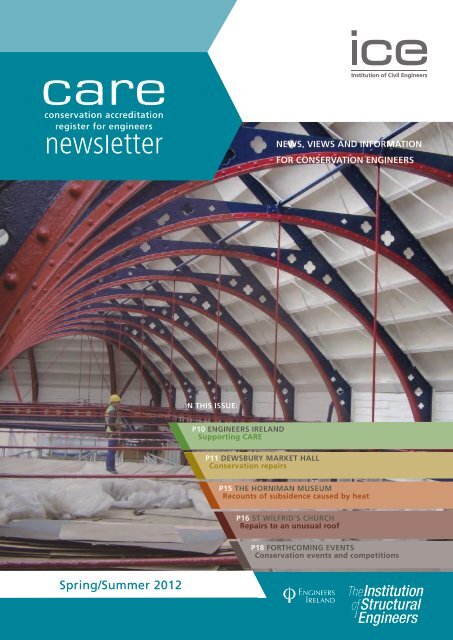
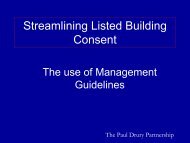
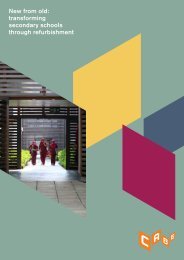
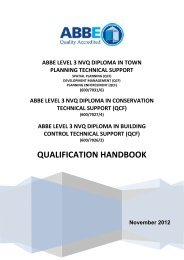
![historic buildings prosecution fines national database - league table [b]](https://img.yumpu.com/39884214/1/184x260/historic-buildings-prosecution-fines-national-database-league-table-b.jpg?quality=85)
